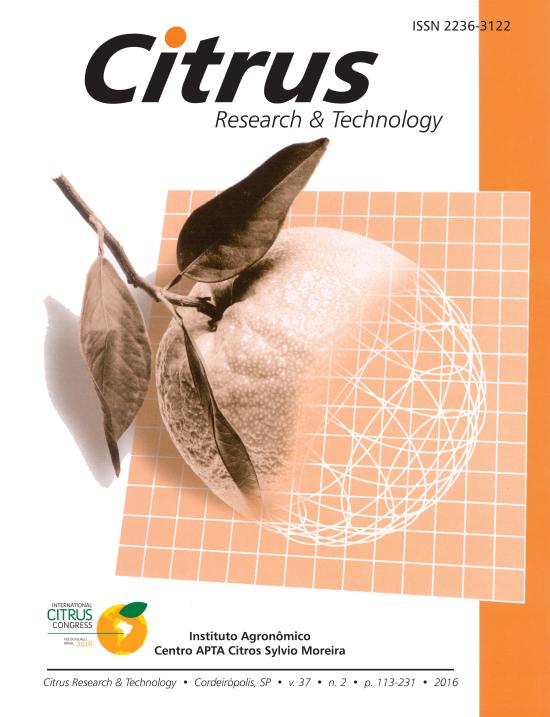EFEITO DO DÉFICIT HÍDRICO E DA PRESENÇA DO VÍRUS DA LEPROSE DOS CITROS NA TEMPERATURA FOLIAR E SUA RELAÇÃO COM A POPULAÇÃO DE Brevipalpus phoenicis E A SEVERIDADE DA DOENÇA EM PLANTAS CÍTRICAS D
Effect of water stress and citrus leprosis virus on sweet orange leaf temperature and its relationship with brevipalpus phoenicis population and leprosis severity on citrus
Daniel Júnior de Andrade, Carlos Amadeu Leite de Oliveira, Rosângela Santos Falconi, Fernando César Pattaro & Édemo João Fernandes
Resumo
O ácaro Brevipalpus phoenicis é uma das principais pragas dos citros, por ser vetor do vírus da leprose (Citrus leprosis virus, CiLV), agente causal de uma das mais graves doenças da citricultura. Objetivou-se avaliar a influência da temperatura foliar na infestação de B. phoenicis e na severidade da leprose em plantas de citros submetidas a diferentes condições hídricas. Desenvolveu-se o experimento em casa de vegetação, com plantas da variedade Pêra, enxertadas sobre limão Cravo, em esquema fatorial com dois fatores: capacidade de campo em vasos (A) com quatro níveis: (1) 25, (2) 40, (3) 55 e (4) 70% da capacidade de campo do vaso, e infestação com B. phoenicis (B), com três condições distintas: (1) infestação com ácaros virulíferos; (2) infestação com ácaros avirulíferos, e (3) sem infestação com ácaros. A combinação dos diferentes níveis dos fatores (4 x 3) resultou em 12 tratamentos e 7 repetições, num total de 84 vasos. Determinaram-se as temperaturas foliares médias com um termômetro infravermelho portátil. No período antecedente à transferência dos ácaros, as plantas mantidas com menor quantidade de água no solo apresentaram temperatura foliar superior à ambiente e às demais plantas. Após a transferência dos ácaros, observou-se que: a temperatura das folhas foi influenciada pela disponibilidade hídrica; plantas mantidas com menor quantidade de água no solo apresentaram maiores valores do índice de estresse diário (IED); a alimentação de B. phoenicis não provocou estresse vegetal; a leprose acarretou estresse nas plantas e contribuiu para a elevação do IED; a população de B. phoenicis infectada com o CiLV foi maior que a população de ácaro não-infectada; a temperatura foliar influenciou o desenvolvimento de B. phoenicis; o aumento da temperatura foliar esteve correlacionado à severidade da leprose, não sendo os teores de nitrogênio foliar influenciados pelo déficit hídrico nem pelos ácaros.
Palavras-chave
Abstract
The mite Brevipalpus phoenicis (Geijskes) is one of most important pests of citrus in Brazil due to its involvement in the transmission of Citrus leprosis virus (CiLV), the causal agent of leprosis, one of the main citrus diseases in the country. The objective of this study was to assess the influence of leaf temperature on B. phoenicis infestation and leprosis incidence in citrus plants submitted to different hydric conditions. This study was conducted under greenhouse conditions, with one-year-old sweet orange plants of 'Pêra' variety grafted onto Rangpur lime. The experiment was carried out in a factorial design constituted by two factors: pots (A) with four levels: (1) 25, (2) 40, (3) 55, and (4) 70% of field capacity, and infestation factor (B) with three conditions: (1) infestation with viruliferous mites, (2) infestation with non-viruliferous mites, and (3) without mite infestation. The factors combination with the respective levels (4 x 3) resulted in 12 treatments that were repeated 7 times, totaling 84 pots. Average leaf temperatures were measured using a portable infrared thermometer. Prior to the mite transference, plants grown on pots with lower water concentration exhibited average leaf temperatures higher than that of the air and those from the other treatments. After the mite transference, it was possible to determine that: the leaf temperature was influenced by the water availability of the soil; plants grown on pots with lower water concentrations showed higher values of Daily Stress Index (DSI); while feeding of B. phoenicis did not result in detectable stress in the plants, the presence of the disease did (observed by an increase in DSI); viruliferous B. phoenicis populations reached higher peaks than those of non-viruliferous mites; the increase in citrus leaf temperature had positive correlation with the severity of leprosis; the percentage of nitrogen on the leaves was not influenced by differences in water availability or by the presence of the mites.

